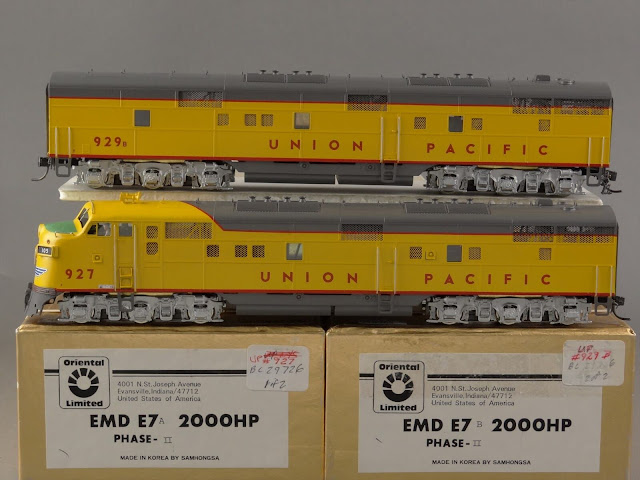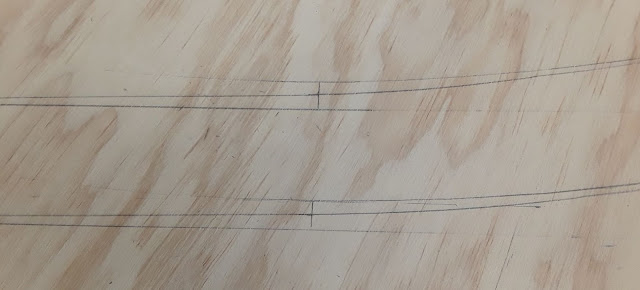Our featured Victorville locomotive type this time is Union Pacific's EMD E7 passenger diesel, and my layout progress report is about preparing the benchwork for the laying of track.
In August of 1946 the UP received 13 new EMD E7 diesels from EMD (six A units and seven B units). One ABB set was lettered for the City of San Francisco (which we won't cover), one ABB set was lettered for the City of Los Angeles (COLA), and the rest were for a general pool for any streamliner trains.
Here's a photo by Jack Whitmeyer taken in late 1946 in Riverside, CA, showing the E7 set 927A (ABB) with its COLA lettering on the red banners on the sides:
But the COLA lettering on this set only lasted until the spring of 1947, when the lettering was removed and the red banners were left blank. Color photos are hard to find, but here are these same units arriving in Chicago with the City of Los Angeles train and with blank red banners in April of 1947:
Two of UP's E7s, A units 930A and 931A, came with blank red banners when new. Chard Walker shot 931A and a B unit leaving Victorville through the Upper Narrows in 1947:
Here's a shot by Frank Peterson, showing an ABA set of E7s led by 931A at Summit in Dec. 1946, after getting help from a UP 2-8-8-0:
Then in March of 1948, eight of these E7 units (the jointly-owned ones) got renumbered with a J suffix; for example, 927A became 988J. The other five units also got renumbered, but without the J suffix; for example, 959A became 998. You can find all of these renumberings at Don Strack's excellent Utah Rails website.
Then in December of 1948, the eight units with the J suffix got renumbered again by dropping the J suffix; for example, 989J became 989. The other five units were not renumbered again. And three of the units left the UP and joined the SP or C&NW, including the former 927A (988J). At the same time, the units that had the blank red banners lost them in favor of "Union Pacific" lettering on the sides of the units.
Some units had already come with the UP lettering, such as 959A, seen here when new:
As for passenger train assignments, at first the 927A ABB set (927A-928B-929B) was assigned to the City of Los Angeles, as it had that lettering on its sides. But once that lettering was gone, the UP mixed the E7s with their earlier E units (E2s and E6s) and with F3Bs on any of the streamliner trains.
When the E8s arrived in 1950 and 1953, the E7s were sometimes mixed with them or downgraded to the secondary trains. When the E9s arrived in 1954, the UP no longer needed the E7s on the Los Angeles trains, and they were sent elsewhere.
Let's look at a few HO models. Broadway Limited made E7 sets both with and without the red banners, including the blank red banners, as seen here with the banners with COLA lettering:
Before that, Proto 2000 had also made the E7s both with and without the COLA banners, as seen here without the banners:
Oriental Limited also made the E7s in brass:
Turning now to my layout progress, I spent a week getting the sections to match up so there were no little bumps in going from one section to the next. I crawled underneath, loosened some bolts, raised the lower sections up on temporary short legs, then bolted them back together in better alignment. I also added shims inside the wider cracks between sections and sealed them with wood filler.
Then I got out my belt sander and posed for a photo before smoothing out all the section joints. That tool always works great for this job:
Then this past week I drew all the pencil lines for the mainline tracks on the plywood. I drew the nearer straight sections 3.25" in from the edges, to clear the legs that stick up there, and the two mainline tracks are spaced 2.25" apart everywhere. I used my poster board curved template to draw the 36" radius inside curves and the 38.25" outside curves.
Here's a view showing the curved template in the foreground:
And here's a view from the other end, showing the straight template with some roadbed and track to illustrate the clearance from the legs:
Note above that the curve is offset by 1/2" at the tangent point with the straight track. That allows me to draw in an easement between the curve and the tangent. Here's a close-up of what the pencil lines look like at the tangent point, with a 12" long easement on each side of that point:
At some points the easements will have to be shorter, if there's a turnout close by.
My next step is to draw in all the crossovers and sidings that are adjacent to the mainlines. But first I need to decide where the best locations for the crossovers are, and I'm in discussions with my helpful advisor, Tim Fisher, about that. Here's a photo of Tim beside his HO layout depicting the Santa Fe in Pampa, TX:
Meanwhile, another helpful friend, architect Jim Coady, upgraded his CAD drawings of the elevated fuel oil tank that was inside the Victorville wye by adding the ladder, platform, handrails, and oil pipes, as seen in this cover page:
We'll see what I can get done in the next two weeks.














No comments:
Post a Comment